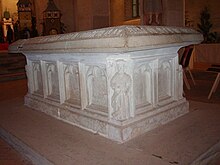Irene of Byzantium

Irene von Byzantium (* 1177 or 1180/81 in Constantinople ; † August 27, 1208 at Hohenstaufen Castle ; also called Eirene , Irene Angelina and Irene Maria ) was the wife of the Roman-German King Philip of Swabia .
Life
She was born in Constantinople in 1177/81 as the daughter of the Byzantine emperor Isaac II Angelus . Her first marriage was in 1193, when she married the Norman King Roger III. of Sicily , who died shortly afterwards. In 1197 she became the wife of Friedrich Barbarossa's youngest son , later King Philip. When they married, she took the name Maria. On September 8, 1198, she was present at Philip's coronation in Mainz, but it is uncertain whether she was also crowned.
She had seven children with him, four of whom reached adulthood:
- Beatrix (1198–1212), married Emperor Otto IV of Braunschweig (1176 or 1177–1218) in 1212 . She died a few weeks after the wedding
- Kunigunde (1200–1248), married King Wenceslaus I of Bohemia (1205–1253) in 1224 ,
- Marie (1201–1235), married Duke Henry II of Brabant (1207–1248) in 1215 ,
- Beatrix the Younger (1205–1235), married King Ferdinand III in 1219 . of Castile and León (1199–1252).
After her husband was murdered in Bamberg in June 1208, she withdrew to Hohenstaufen Castle , heavily pregnant and ill , where she died in August 1208 while giving birth to a daughter who also passed away shortly afterwards. Irene was buried in the Lorch monastery in the Hohenstaufen region . She is the last and as the only queen the highest-ranking Staufer woman buried there. In 1475 Abbot Nikolaus Schenk von Arberg had all the Staufer graves in the central nave, in front of the steps of the choir and in the choir opened, and the remains were brought together in a tumba in the central nave of the monastery church.
Afterlife
Walther von der Vogelweide praised it in a contemporary poem as "Rose without thorn, the dove special Gall" ( saying for Christmas in Magdeburg ).
The now heavily weathered crowned seated figure of a woman is dated around 1207 and is assigned to a king who is inscribed as King Philip. It was located at the stone bridge in Regensburg.
A gold ring with enamel inlay found in the 1830s during demolition work under the rubble of a stone coffin in Lorch Abbey was attributed to her. This Irenenring was lost in the 20th century.
On December 16, 1898, a memorial plaque for Irene was unveiled in the south transept of the monastery church. Irene was depicted several times next to her husband Philipp, for example in Weißenau manuscripts at Zeil Castle , in the 19th century at Stolzenfels Castle near Koblenz or in a depiction of Walther von der Vogelweide, who sang to the royal couple in 1198.
On the occasion of the 800th anniversary of her death, a Staufer stele was erected at the entrance to Lorch Abbey in 2008 .
In 2011, the Friends of the Memory of Queen Irene Maria von Byzanz eV was founded in Göppingen and has since awarded an Irene Medal every year as a traveling award. The medal went to the draftsman and painter Hans Kloss (2013) and the writer Gunter Haug (2015) , among others .
literature
- Bruno W. Häuptli: IRENE (Angelou) from Byzantium. In: Biographisch-Bibliographisches Kirchenlexikon (BBKL). Volume 28, Bautz, Nordhausen 2007, ISBN 978-3-88309-413-7 , Sp. 858-862.
- Maria Magdalena Rückert : Irene-Maria, wife of Philip of Swabia, and her children. In: Karl-Heinz Rueß (Ed.): Women of the Staufer. Göppingen 2006, pp. 74-89. online .
- Gunter Haug : The rose without a thorn. Irene of Byzantium, Queen of the Hohenstaufen . Landhege-Verlag, 2011, ISBN 978-3-943066-00-5 .
Web links
- Friedrich Roemer: Irene of Byzantium. In: Local history sheets Balingen. 21, 1974, pp. 987-990 ( PDF )
Remarks
- ↑ Peter Csendes : Philipp von Schwaben. A Staufer in the struggle for power . Darmstadt 2003, pp. 145, 156, 159, 165.
- ↑ http://www.reinis-welten.de/regensburg/bauwerkeplaetzeundsonstigesberuehmtes/steinernebruecke/denkmaelerandersteinernenbruecke.html . See also Figure 1878 .
- ↑ Klaus Graf : On the dating of the so-called "Irenenring" from Lorch Monastery on archiv.twoday.net. Retrieved September 10, 2014.
- ↑ Illustration in Staufer Queen Irene - Rose without thorns on hans-kloss.de. Retrieved September 10, 2014.
- ↑ wubonline.de
- ↑ digilib.zikg.eu
- ↑ bbf.dipf.de
- ↑ Stauferstele monastery Lorch on stauferstelen.net. Retrieved September 10, 2014.
- ^ Website of the Circle of Friends in Memory of Queen Irene Maria von Byzanz eV
| predecessor | Office | Successor |
|---|---|---|
| Constance of Sicily |
Roman-German Queen September 8, 1198 to June 21, 1208 |
Beatrix of Swabia |
| personal data | |
|---|---|
| SURNAME | Irene of Byzantium |
| ALTERNATIVE NAMES | Irene von Schwaben; Eirene; Irene Angelina; Irene Maria |
| BRIEF DESCRIPTION | Staufer Queen |
| DATE OF BIRTH | 1177 or 1180 or 1181 |
| PLACE OF BIRTH | Byzantium |
| DATE OF DEATH | August 27, 1208 |
| Place of death | Hohenstaufen Castle |

